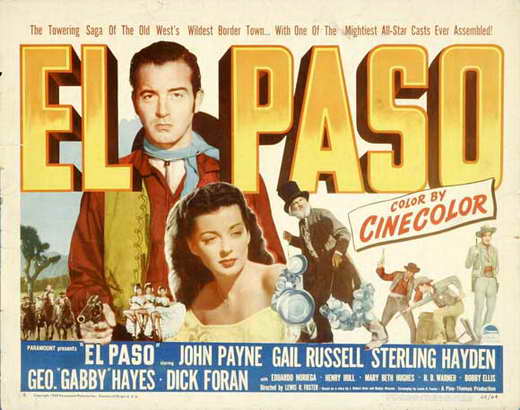« Coffee Break | Main | Let the Corpses Tan »
January 01, 2019
El Paso

Lewis R. Foster - 1949
KL Studio Classics BD Region A
Especially knowing that writer-director Lewis Foster won the Academy Award his part in writing Mr. Smith goes to Washington, I wish that a little more care had been put in the writing of El Paso. Taking place immediately after the Civil War, the basic plot is of a Confederate veteran who shows up in town for business with an old family friend from Charleston, South Carolina. The town is run by a corrupt strong man with the sheriff and deputies doing his bidding. Operations are from the back of the bar. Former soldiers are losing their homes in the name of unpaid taxes that built up during the war years. The lawyer realizes that his skills as a lawyer are needed, but he also learns how to best be effective with a gun.
Had more attention been paid to history, El Paso might have been more interesting. Most of the film takes place at the western set of the Iverson Ranch, making the cinematic El Paso look like a generic western town. The real El Paso was a bit more developed during the Civil War era, and an active center of activity on behalf of the Confederate army. Most Texans supported the secession from the United States. The basic plot premise is also faulty as there is no explanation as to what the bad guys were doing during the war years. Essentially, a vaguely historical set-up is ignored once John Payne and the rest of the cast steps off the stagecoach in that town that looks like it is part of almost any random Western.
Foster is stronger visually, with a penchant for tracking shots within the length of the bar where several scenes take place, as well as following along on the street where the final gun battle takes place. There is also some nice second unit work with stunt doubles seen from the distance, camera aiming up with the riders against some very imposing rocks or sky. Best is the final gun battle, filmed during a wind storm, with the dust and sand creating a very hazy effect, blurring the details in shades of brown, and providing an abstract quality to that scene.
The film was produced by William Pine and Willam Thomas, who previously provided low or modestly budgeted action movies for Paramount. This was the team's first million dollar production, though several cost cutting measures are apparent. The film played at New York City's Paramount Theater, and received quite a harsh review from the New York Time's Bosley Crowther: "It is billed as a top-flight production-by William C. Thomas and William H. Pine. Well, the boys may now be billed as Williams and they may have hit the Paramount, but El Paso is still Pine and Thomas in the same old low-budget groove. Indeed, if our memory serves us, it isn't even them at their best, but is rather a third or fourth rate rehash of a standard Western plot. And Mr. Payne's performance as a young lawyer who finally puts to rout a gang of frontier villains is way below their grade."
El Paso will probably be of most interest for those devoted to older Hollywood Westerns. The film was shot in an inexpensive color process called Cinecolor, a two-color process favored by some of the poverty row studios. Maybe I needed to do some fine-tuning on the color, but reds appeared as Halloween orange. It's fairly easy to why Cinecolor was a short-lived process.
Gail Russell is on hand as the obligatory love interest. Considering that she seems to have less screen time than bad guys Sterling Hayden and Dick Foran, I had to wonder if the role was taken simply as part of Russell's contractual obligations with Paramount, or if her alcoholism had in any way affected her performance. Gabby Hayes provides what passes for comedy as "Pesky", the worst entrepreneur in the West, who begins with a suit and top hat, and ends wearing nothing but a blanket. Film historian Toby Roan's commentary track for the blu-ray covers the history of Pine-Thomas productions, the production of El Paso, and brief biographies several cast members. The film will probably be most appreciated by hardcore Western aficionados. For others, El Paso serves as an example of genre filmmaking at a time when the studio system was coming apart, and two former studio publicists proved prescient in the ways that film production would eventually evolve.
Posted by Peter Nellhaus at January 1, 2019 08:50 AM
